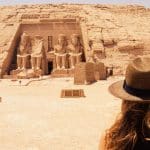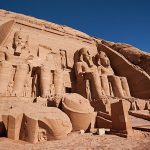About the Temple of Abu Simbel
The Temple of Ramses II of Abu Simbel is among the most striking historical sites worldwide. Numerous travelers who tour Egypt explore The Temple of Abu Simbel. The complex consists of two gigantic rock-cut temples that were built near the city of Aswan.
The huge astonishing temples of Abu Simbel are now situated at the Southernmost area of the Egyptian around 290 kilometers to the South of the amazing city of Aswan.
The Temple of Abu Simbel is included in the UNESCO world heritage sites because of its unique construction methods and its marvelous architectural details.
The discovery of the Abu Simbel Temples
The Temple of Abu Simbel was discovered in 1813 when a Swiss archeologist revealed the facade of the larger temple of Amun. However, he was never able to enter the Temple except four years later. Historians assert that the name Abu Simbel points to the local boy who led to this amazing discovery.
The Temple of Abu Simbel today
The larger temple at Abu Simbel was dedicated to the three most dominant gods in Egypt in the 13th century BC, Amun, Ra, and Ptah. The most marvelous feature of this temple is the facade with the four huge statues of Ramses II that were cut out of rocks.
The facade of the temple is 20 meters high and more than 35 meters in width. Ramses II is represented wearing the two crowns of Upper and Lower Egypt while sitting on the throne.
Inside the temple, there is the huge and wonderful hypostyle hall that is 18 meters in length and 16 meters in width with eight huge columns supporting its ceiling.
The Temple was brilliantly constructed in a way that allows the rays of the sun to reach inside the sanctuary of temple two times every year; on the 21st of October and the 21st of February to light the statues of the gods situated inside, except that of Ptah as he was always associated with hell.
The smaller temple at Abu Simbel, the Temple of Queen Nefertari, and the most favorite wife of the king Ramses II is situated around 100 meters to the North East of the larger temple.
The Temple dedicated to the goddess Hathour is featured with its rock-cut facade. It consists of a number of statues of the Queen on one side and the king to the other side. These statues are more than 10 meters in height. This is the only example in the Pharaonic history where the king and the queen have statues of both height and size.
Once inside the temple, tourists enjoying their holidays in Egypt fall in love with the hypostyle hall featured with its six pillars with the Queen represented in their stone capitals. The walls of the temple host many wall paintings and carves of the Queen presenting offerings to the gods and in different other scenes as well.







0 Comment